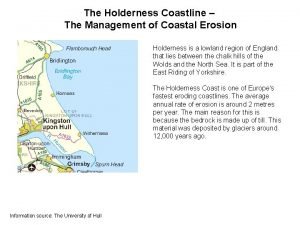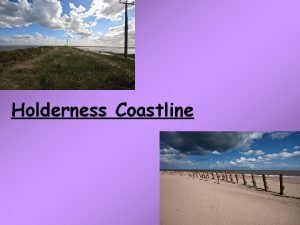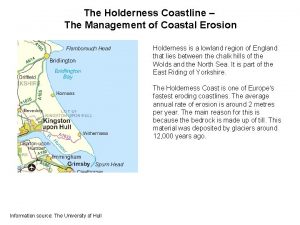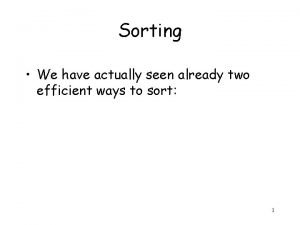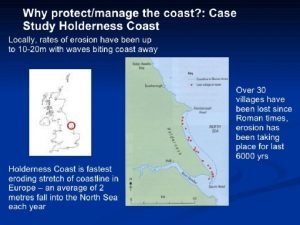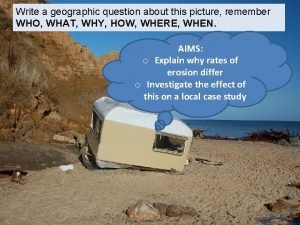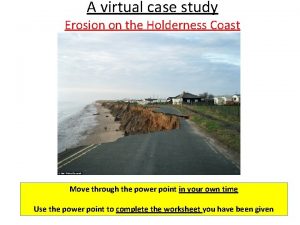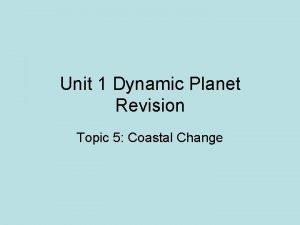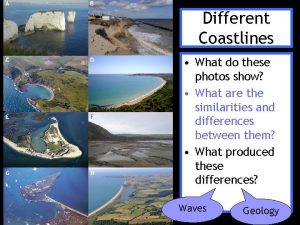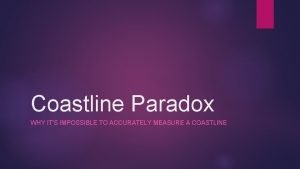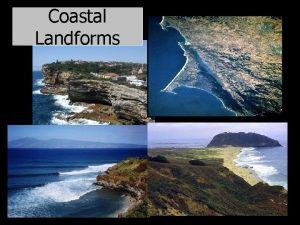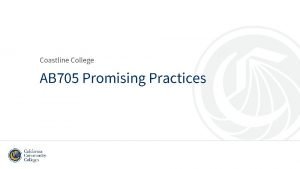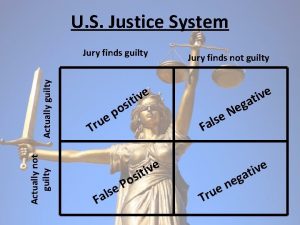The Holderness Coastline What actually happened Identify which












- Slides: 12

The Holderness Coastline: What actually happened? Identify which forms of sea defence are being used along the coastline Evaluate the success of the coastal defences being used Analyse the choices made by the East Riding of Yorkshire Council

Bridlington and Hornsea Easington

Flamborough Head

Bridlington

Mappleton and Hornsea Grass growing on the cliffs Big, sandy beach In 1991, The East Riding of Yorkshire Council (ERYC) spent £ 2 million here on coastal defences

Aldbrough Use an Ipad to watch the following clip to help with your questions… https: //www. bbc. co. uk/pro grammes/p 00 xrlnl

Withernsea

Easington

Kilnsea The old village in Kilnsea has been completely lost to the sea and a new village has been built. Due to the amount of erosion here, sea defences were built as early as 1847! But, they have obviously not solved the problem and are now very worn out. It will cost a lot of money to restore old defences. The image shows plaques attached to one of the sea defences in Kilnsea

Spurn Head is the most southerly part of The Holderness Coastline. It is an excellent example of deposition as a large spit has been created which is over 5. 5 km long. It is made up of the material which has been eroded from the rest of The Holderness Coastline as long shore drift is moving the eroded material in a southward direction.

THE FUTURE • It costs £ 300 million a year to maintain the sea defences along The Holderness Coastline. • In recent years, parts of the coastline have eroded as much as 11 metres in just one year. • Estimates suggest by 2027 nearly 14, 500 metres of coast will have been eroded from this coastline. • Some people argue managed retreat would be a better option…

Managed retreat • Managed retreat is the controlled flooding of coastal areas. If an area is at high risk of erosion, managed retreat could be an option. It usually occurs where the land is of low value, for example farm land. Advantages Disadvantages • This is a cheap option compared to paying for sea defences. • Creates a salt marsh which can provide habitats for wildlife and a natural defence against erosion and flooding. • Salt marshes are diverse ecosystems supporting many species. • Land is lost as it is eroded by the sea. • Landowners will loose their land (this can often be their business as well) • Landowners need to be compensated - this can cost between £ 500 - £ 1000 per square metre.
 Holderness coastline map
Holderness coastline map Holderness coastline map
Holderness coastline map Holderness coastline map
Holderness coastline map Image search reverse
Image search reverse Groynes
Groynes Holderness coast geology map
Holderness coast geology map What is happening in this photo
What is happening in this photo Discordant coastline
Discordant coastline An abundance of coal an irregular coastline
An abundance of coal an irregular coastline Length of maine coastline
Length of maine coastline Concordant and discordant coastlines
Concordant and discordant coastlines The coastline paradox
The coastline paradox Emergent vs submergent coastline
Emergent vs submergent coastline
